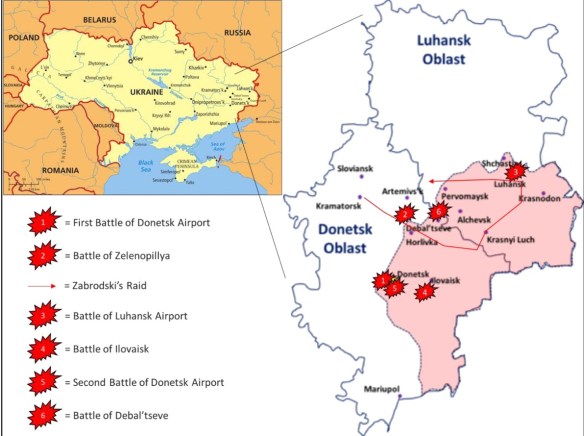
Despite Russian efforts to confound Ukrainian counteraction, Ukrainian forces were successful at pushing back Russian and partisan forces to the boundaries of the Donetsk and Luhansk oblasts. Ukrainian success in these early operations triggered a transition in the war- Russia became far more aggressive in response. As a result, Russia unleashed conventional warfighting capabilities, techniques, and force structures not recently seen on modern battlefields. Likewise, the Russian army became more overt in its presence and began to funnel more armored and mechanized combat systems into the Donbas, to include the venerable T-80 and T-90 main battle tanks. In response to the shifting momentum following the battle of Zelenopillya, Ukraine launched an armored raid into the Donbas, seeking to thwart Russian initiative, weaken DPR and LPR partisan forces, and assist a beleaguered Ukrainian formation isolated at the Luhansk airport. Analyst Phillip Karber called the raid the longest armored raid in history, as the Ukrainian 95th Air Assault Brigade, under command of Colonel Mykhailo Zabrodskyi, penetrated the Russian front and wreaked havoc deep within the Russian-controlled region. The raid resulted in a two hundred-mile excursion through Russian and partisan held territory in which Zabrodskyi’s 95th Brigade scored a number of tactical successes.
“Zabrodskyi’s Raid,” as the mission became known, launched from the ATO headquarters in Kramatorsk and advanced south and east along highways H21 and E50. Zumbrowskyi’s 95th Brigade fought conventional ground combat with Russian and partisan forces at Bakhmat, Debal’tseve, Saur-Mogila, and Luhansk. The 95th Brigade, being an Air Assault brigade, was significantly augmented with tanks, mechanized infantry, and self-propelled artillery to support the operation. Additionally, Zabrodskyi led the brigade through a contested river crossing on Highway 21 along the Mius River, outside Krasnyi Luch. Following the successful river crossing, the 95th Brigade fought its way through Krasnyi Luch in route to Luhansk.
The 95th Brigade’s combat at Luhansk centered largely at the airport and was conducted from July 13-24, 2014. Fighting at Luhansk, the 95th Brigade, consisting of approximately sixty to seventy tanks and infantry fighting vehicles had two objectives. First, it was to assist the encircled Ukrainian unit and prevent its destruction. Second, the 95th Brigade was to regain control of the airport from Russian and partisan forces. On July 13, 2014, Zabrodskyi’s brigade penetrated the Russian defensive perimeter, reached the airport, and made contact with the beleaguered Ukrainian forces defending the airport. Ukrainian forces conducted joint operations, employing their air force in conjunction with the 95th Brigade to attack the Russian defenders at the airport. The unified action of the Ukrainian armed forces loosened the grip Russian forces maintained around the airport, allowing the trapped formation to extricate themselves. As part of this effort, Russian forces employed air defense missiles to deny Ukrainian forces resupply at the airport and to disrupt their ability to conduct joint operations. As a result, the Ukrainian air force lost two aircraft, an An-26 on July 14 and a Su-25 on July 16. Additionally, two more Su-25 aircraft were downed by Russian air defenses on July 23 at Saur-Mogila. However, exhausted and out of supplies, Zabrodskyi’s 95th Brigade culminated on July 23. Later that day the force withdrew from the Luhansk airport, returning to the relative safety of Kramatorsk. Zabrodskyi’s raid succeeded in arresting Russian offensive action, but only briefly. The raid also succeeded in relieving the isolated Ukrainian force at Luhansk airport, but the mission failed to wrest the facility from Russian control.